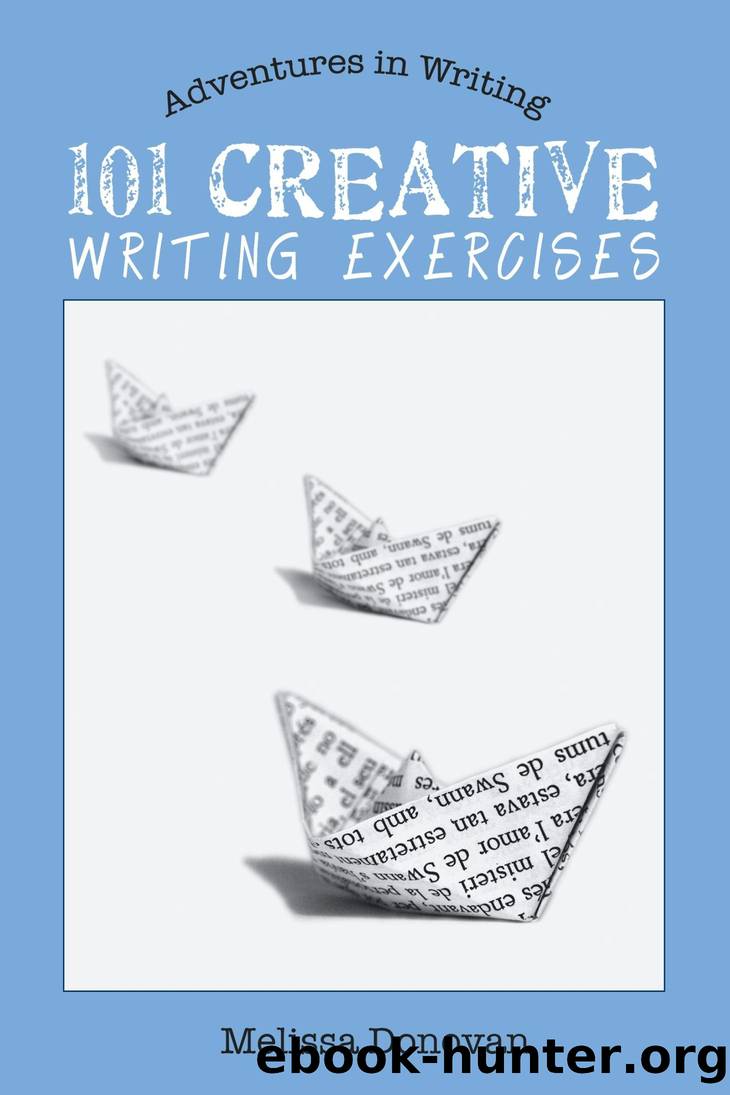101 Creative Writing Exercises (Adventures in Writing) by Melissa Donovan

Author:Melissa Donovan
Language: eng
Format: epub
Tags: writing reference
Publisher: Melissa Donovan
Published: 2012-02-04T00:00:00+00:00
Chapter 7
Form Poetry
Working within a framework
7.1 Couplets and Quatrains
Poetry may not be the most widely read or published form of writing these days, but itâs probably the most widely written.
Despite the lack of enthusiasm for the form among readers and publishers, poetry still has a traditional place in our culture. Youâll hear poetry read at most significant events, such as weddings, funerals, graduation ceremonies, and presidential inaugurations. Poetry is the foundation for most childrenâs books, and itâs so closely related to songwriting that in many cases, itâs hard to tell the difference between a poem and a song lyric.
Couplets and quatrains are two of the most basic building blocks of poetry.
Couplets
A couplet is a pair of lines in a poem. The lines usually rhyme and have the same meter or syllable count. Contemporary couplets may not rhyme; some of them use a pause or white space where a rhyme would occur.
Couplets can be used in a number of ways. Some poems are simply a couplet. Other poems are composed of a series of couplets. Stanzas can end with a couplet, or an entire poem can end with a couplet.
Quatrains
A quatrain is either a four-line stanza within a poem or a poem that consists of four lines. Many modern song lyrics are composed of quatrains.
A quatrain may contain one or two couplets. The nursery rhyme âHumpty Dumptyâ is a quatrain of two couplets:
Humpty Dumpty sat on a wall,
Humpty Dumpty had a great fall.
All the kingâs horses and all the kingâs men Couldnât put Humpty together again.
The Exercise
This is a three-part exercise. First, write a couplet (two rhyming lines with the same meter or number of syllables). Then, write a quatrain (it doesnât have to include meter or rhymes). Finally, write a quatrain that consists of two couplets.
Tips: Keep your language and subject matter simple. Aim for catchy language and vivid imagery.
Variations: Mix it upâwrite a poem that consists of a couplet followed by a quatrain and then another couplet. Try using couplets and quatrains to write a song lyric.
Applications: Couplets and quatrains have an infinite number of practical applications for a writer. Couplets are ideal for writing a childrenâs story, because kids gravitate to simple language and rhythmic rhymes. You can also use couplets and quatrains in songwriting and greeting-card poetry.
7.2 Iambic Pentameter
If you chat long enough with a poet, eventually this term is sure to pop up in the conversation. Iambic pentameter is, historically, the most common metrical line used both in poetic verse and in verse dramas.
An iamb is a type of meter (in poetry we call it a foot, which is a unit of poetic measurement). It is an unstressed syllable followed by a stressed syllable: da DUM. Words that are iambs include the following: conCERN, eVOLVE, aMEND, eLUDE, toDAY.
A pentameter is five units (or five feet).
Therefore, iambic pentameter is a line of verse that is five iambs:
da DUM da DUM da DUM da DUM da DUM
Iambic pentameter can be used throughout an entire poem or just in certain lines or stanzas.
Download
This site does not store any files on its server. We only index and link to content provided by other sites. Please contact the content providers to delete copyright contents if any and email us, we'll remove relevant links or contents immediately.
Asking the Right Questions: A Guide to Critical Thinking by M. Neil Browne & Stuart M. Keeley(5572)
Autoboyography by Christina Lauren(5154)
Eat That Frog! by Brian Tracy(4377)
Dialogue by Robert McKee(4270)
Sticky Fingers by Joe Hagan(4060)
Journeys Out of the Body by Robert Monroe(3535)
Annapurna by Maurice Herzog(3395)
Full Circle by Michael Palin(3346)
Schaum's Quick Guide to Writing Great Short Stories by Margaret Lucke(3278)
Elements of Style 2017 by Richard De A'Morelli(3278)
The Art of Dramatic Writing: Its Basis in the Creative Interpretation of Human Motives by Egri Lajos(2944)
Why I Write by George Orwell(2849)
The Diviners by Libba Bray(2839)
In Patagonia by Bruce Chatwin(2828)
The Mental Game of Writing: How to Overcome Obstacles, Stay Creative and Productive, and Free Your Mind for Success by James Scott Bell(2816)
The Fight by Norman Mailer(2792)
Atlas Obscura by Joshua Foer(2757)
Venice by Jan Morris(2494)
The Elements of Style by William Strunk and E. B. White(2413)
